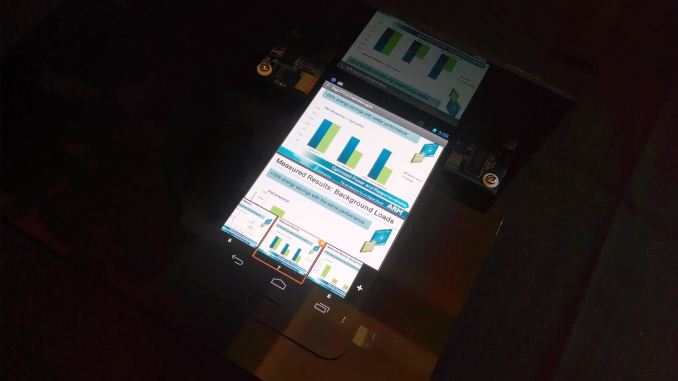Samsung Announces big.LITTLE MP Support in Exynos 5420
by Brian Klug on September 11, 2013 1:22 AM EST- Posted in
- Smartphones
- Arm
- Exynos
- Mobile
- Tablets
- exynos 5 octa
It hasn't been much of a secret in the SoC space that big.LITTLE on the original Exynos 5 Octa (5410) didn't end up working in the most optimal fashion. Instead of using core migration or the Heterogeneous Multi-Processing (HMP) big.LITTLE models, the 5410 instead used cluster migration which meant either all 4 ARM Cortex A15s or 4 ARM Cortex A7s were lit up.
For those not familiar, there are three big.LITTLE models, core switching, in which any of the A7 and A15 cores can be swapped, cluster switching, in which either all A7s or all A15s can be swapped, or HMP, where the kernel is aware of all cores and can schedule threads to any of the cores all at once. This final model is coming to Exynos 5420 by the end of Q4 2013 and will be available to partners shipping product based on its reference platform.
ARM gave us a chance to take a look at the HMP enabled Exynos 5420 reference platform running through a few demos, showing the kernel swapping in and out A7s and A15 cores as system workload changed. I got to see these in person but ARM has also posted them on YouTube in quality better than I could've captured.
Exynos 5420 also includes the necessary fixes to the cache coherency interface (CCI-400) that enable it to work this time between the A7s, A15s, and Mali T-628, versus 5410 which didn't enable it and thus suffered loss of efficiency. This makes 5420 the first real platform to take a look at the full promise of ARM's big.LITTLE model.
Source: Samsung












30 Comments
View All Comments
akmittal - Wednesday, September 11, 2013 - link
Now we can call This SoC true Octa core, Snapdragon 800 have competition now.MarcusMo - Wednesday, September 11, 2013 - link
I don't think it's correct to say this is true octa core since afaik only four cores can be active at once.garadante - Wednesday, September 11, 2013 - link
It looks like Brian said Samsung was switching to the third option, HMP (global task switching in the visual), for their new SoC. Which would mean it could actually use all 8 cores at once. Wonder how power consumption would be during this, and if there'd ever be a use for it. I'm guessing it wouldn't be useful at all really. Seems like the most useful scenario would be running the A7 cores for normal lifting and powering up 1-2 A15 cores when you need the performance.MrSpadge - Wednesday, September 11, 2013 - link
Not sure 4+4 HMP is really needed on a phone (more like 2+2 or 2+4), but from a general computational point of view this could be really useful: delegate threads of lower priority to the small cores if the big guys are busy, or tasks where you know they'll be finished soon, so that waking up a big one is inefficient. Intelligent task scheduling does not exactly become easier, though.ivanatpr - Friday, September 13, 2013 - link
Looks like an HMP scheduler for big.LITTLE was added to the kernel for 3.10 via the Linaro Organization (funded by ARM and SoC manufacturers). Seems like it would be a beast of a problem to get right but the kernel is certainly the most logical place to put that decision making logic into.tuxRoller - Wednesday, September 11, 2013 - link
It will be fantastic.I don't know how the heuristics work for the scheduler (how the scheduler makes its descisions will make or break these early efforts) but it should end up using mostly a7s with only bursty a15s. The exception will be games, of course.
The battery life, ideally, will be better.
Now that we've got a heterogenous aware scheduler we can look towards future designs where you have more A7s than A15s (or A53 and A57). That is probably the balance that would make most economic sense, but when sammy first released their devices the best we could do was use the cpufreq driver to migrate within PAIRS of A7/A15.
krazyfrog - Wednesday, September 11, 2013 - link
You should read the article and/or watch the videos, then. All eight cores are now working simultaneously.mjv.theory - Wednesday, September 11, 2013 - link
Watch the third video, all 8 cores can be active at the same timeKrysto - Wednesday, September 11, 2013 - link
This should've been obvious. ARM is making its Mali GPU's very integrated with its Cortex CPU's, and it's only going to do more of that in the future. If you're looking for heterogeneous computing, you're not going to find it in a 3rd party CPU+Imagination GPU. You can expect it from Nvidia and Qualcomm, too, though, because they will make their own CPU's and GPU's.SKRG - Wednesday, September 11, 2013 - link
You said final model is coming by end of Quarter 4, suppose I buy Samsung Galaxy Note 3 in first lot, then the final model of the Exynos 5420 can be updated on Note 3 via software update?